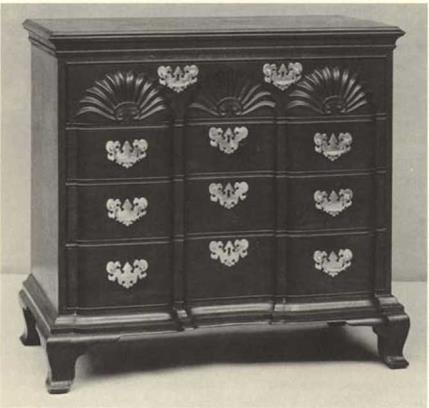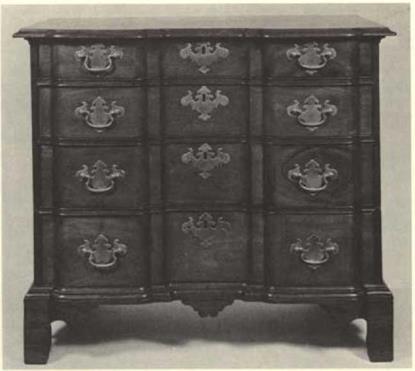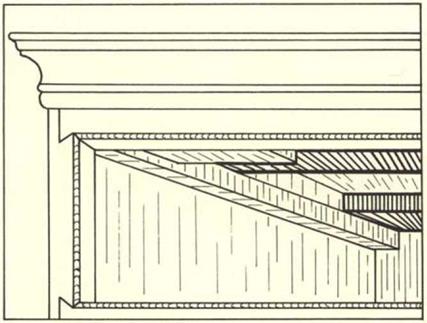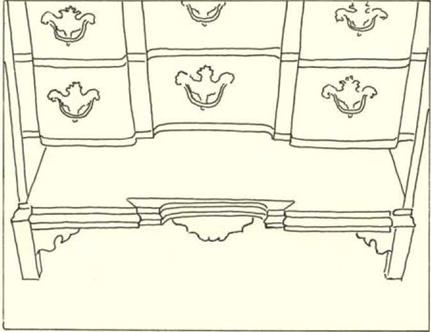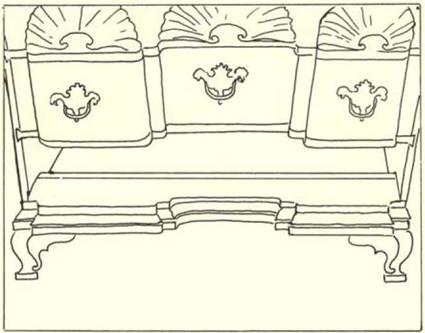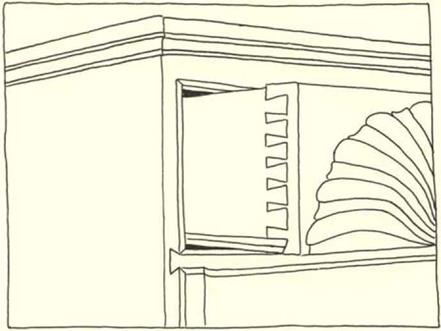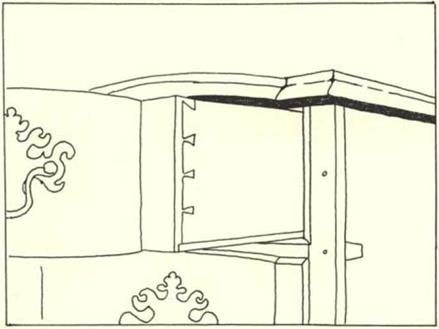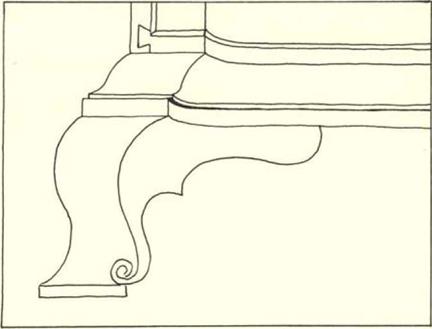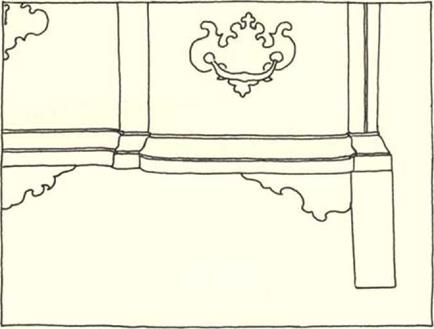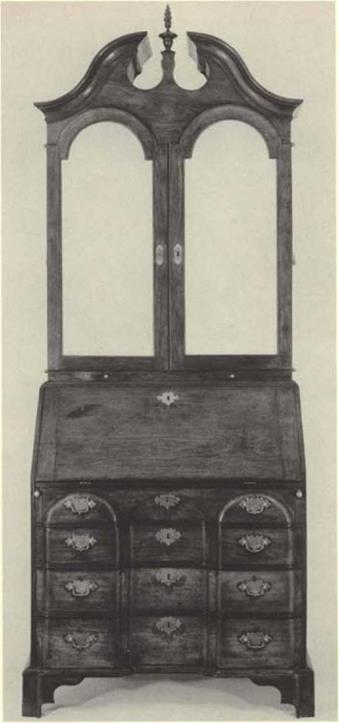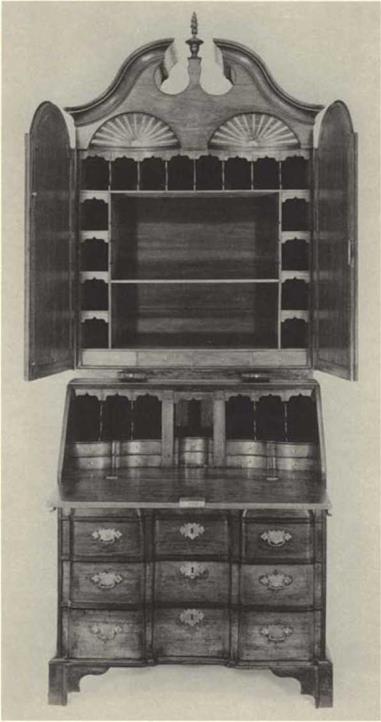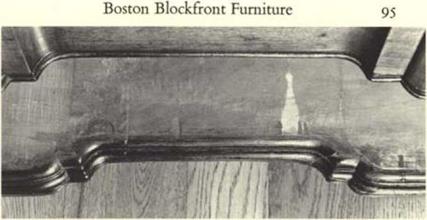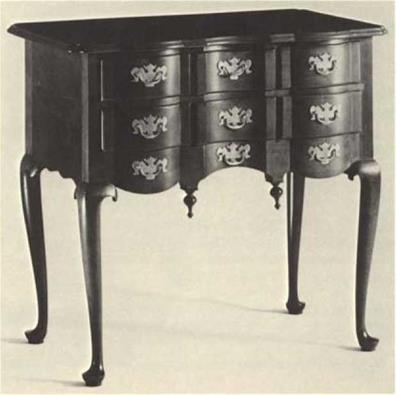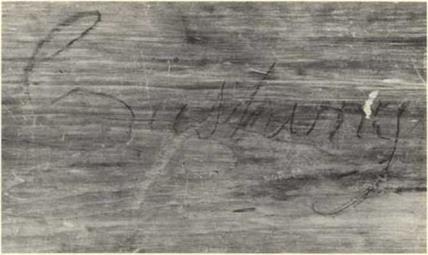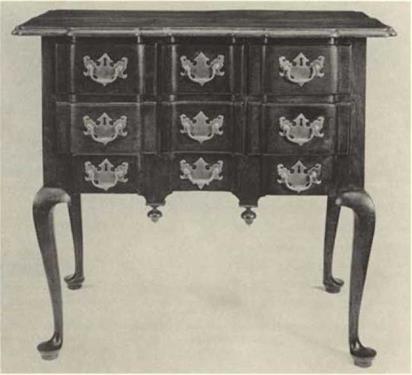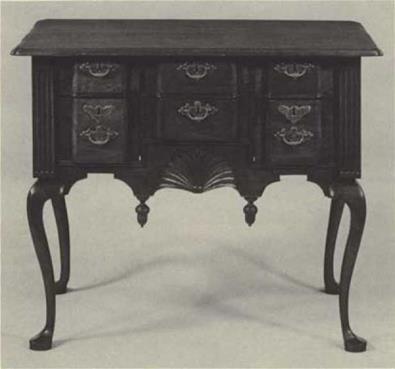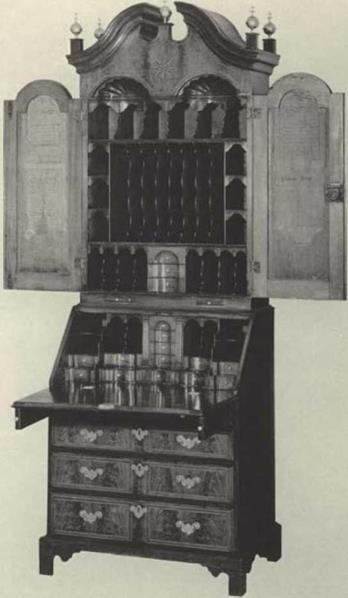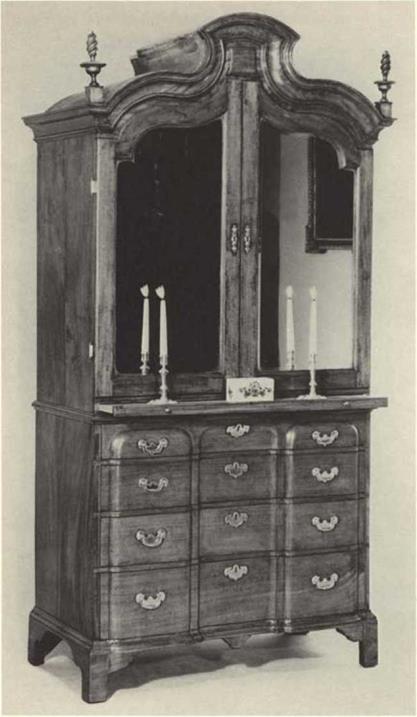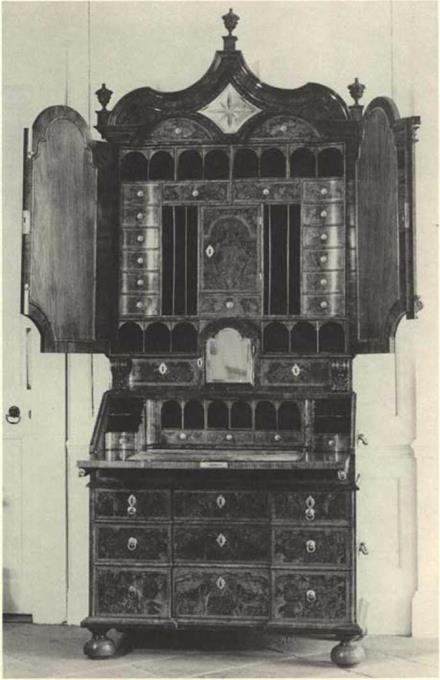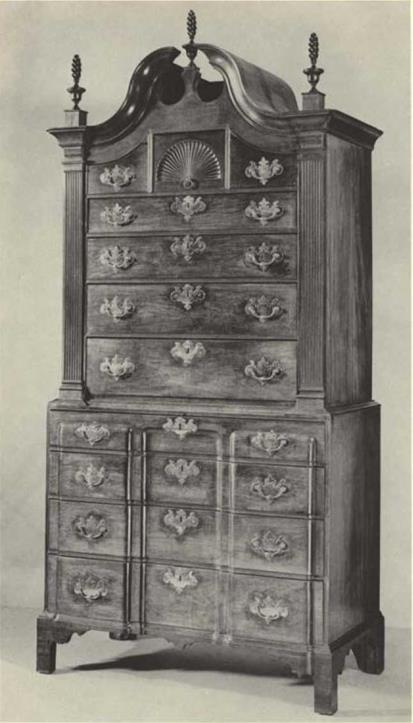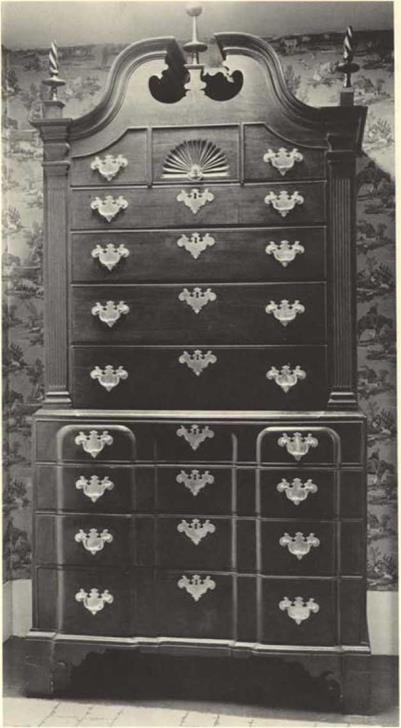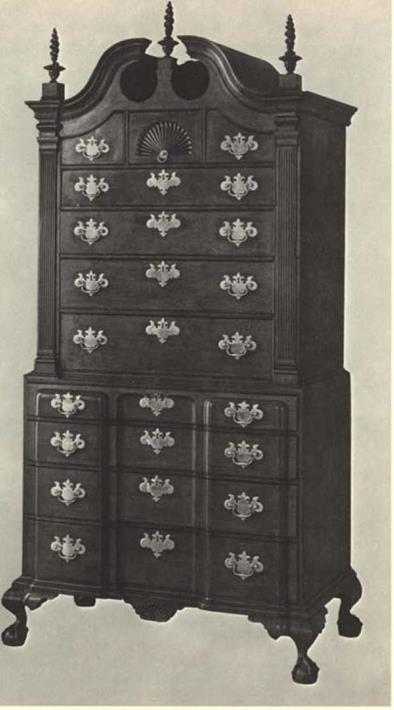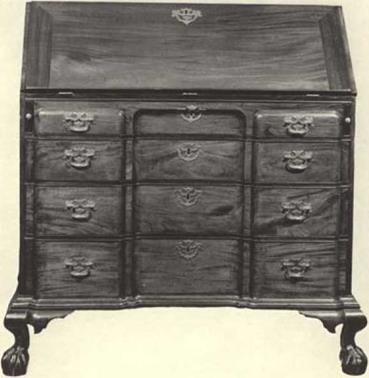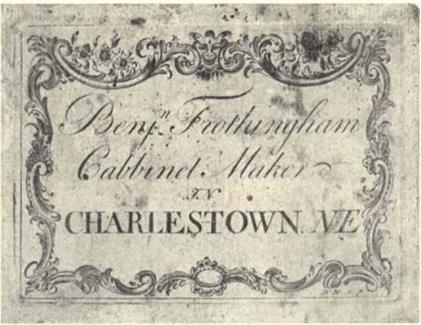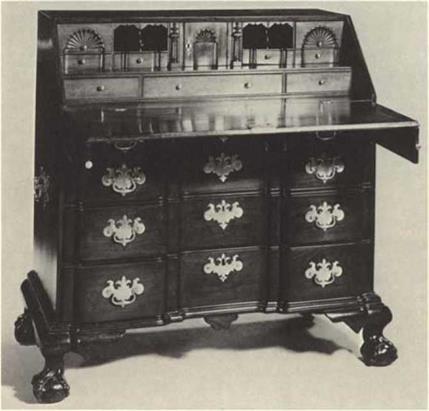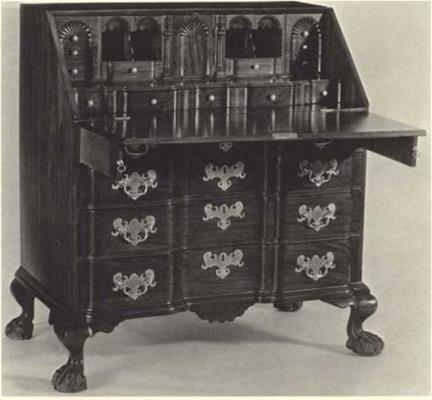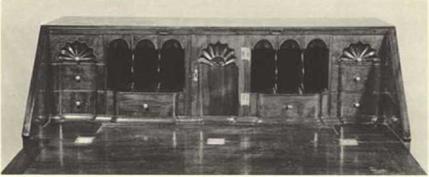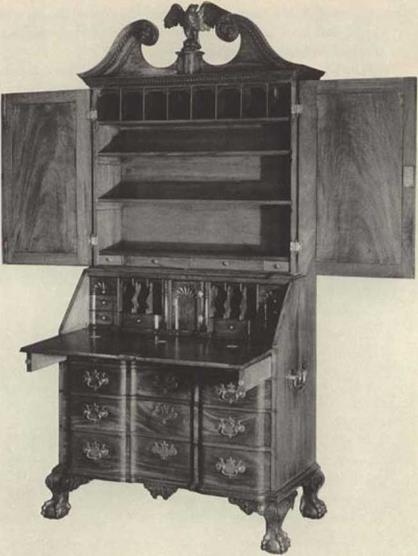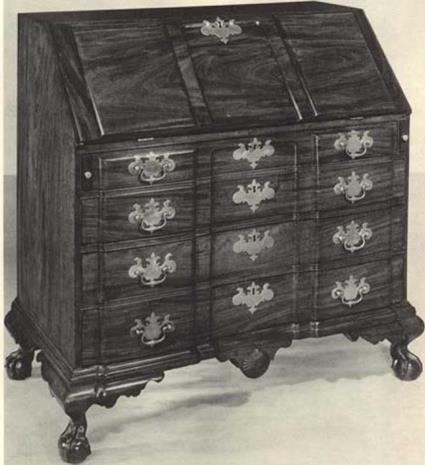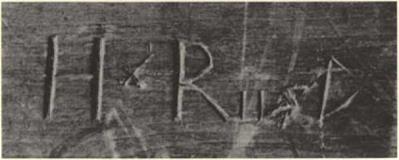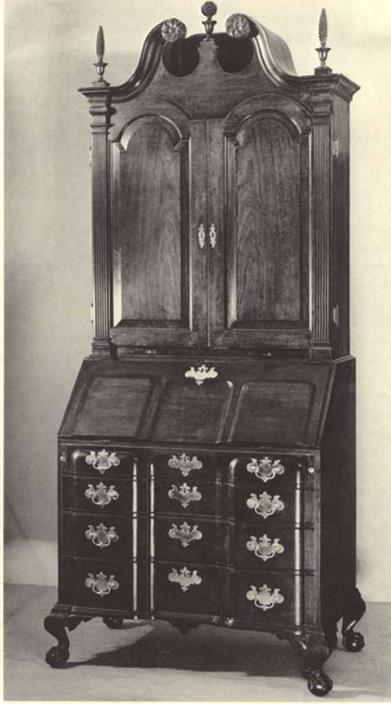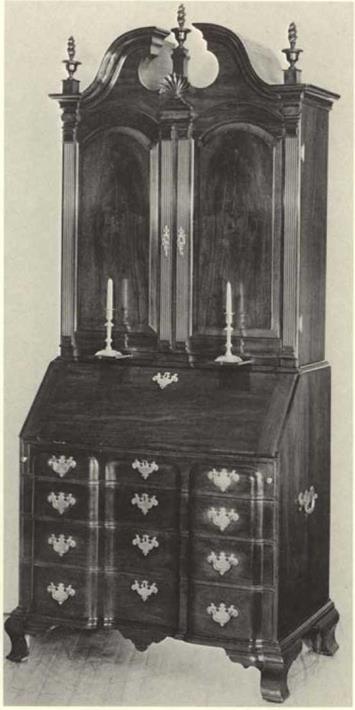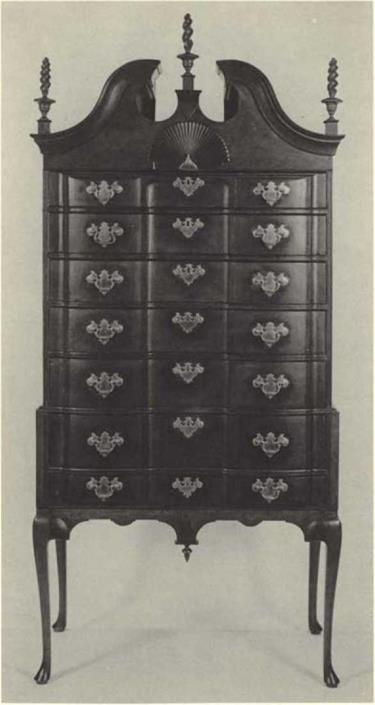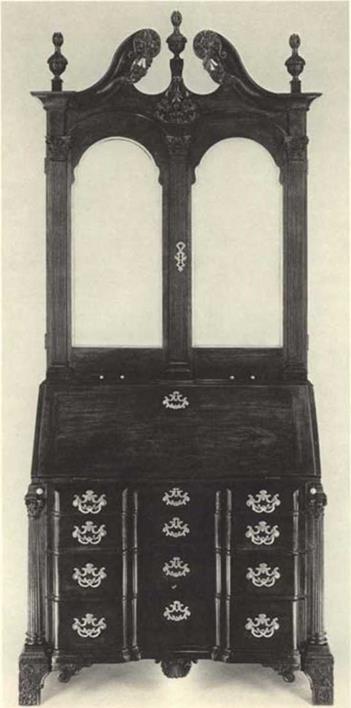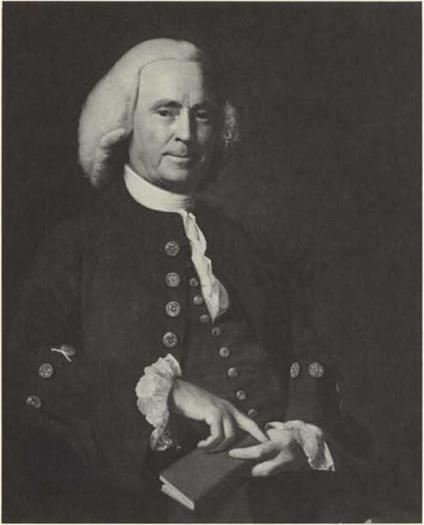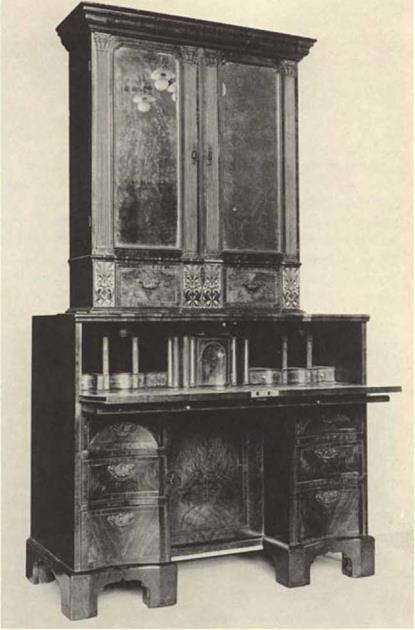The ires arc undeniably forwarder in Massachusetts-Bay, thin either in Решу I vania or New York, The public buildings are more elegant; and there is a more general cum for music, painting, and the belles lettres,1
|
T |
HUS Andrew Burnaby, Vicar of Greenwich, England, described Boston in 1760, He was impressed by die gentle elegance and artistic temper of the inhabitants. Among these was a group of wealthy merchants whose impressive fortunes were often reflected in a fine domestic display. The home of such a merchant, obviously a composite of native craftsmanship and imported wares, is described by John Adams in 17661 “Dined at Mr. Nick Boyl – stoncs,… Went over die Ноше со view the Furniture, which alone cost a thousand Pounds sterling. A Scat it is for a noble Man, a Prince. The Turkey Carpets, the painted Hangings, the Marble Tables, the rich Beds with crimson Damask Curtains and Counterpins, the beautiful Chimny Clock, die Spacious Garden, arc the most magnificent of any Thing I have ever seen, ’2
Mr. Boylston and hu peers surrounded themselves with articles in the latest fashion, and the ruling fashion in Boston, from about 1730 until 176;, was the style knowru today as Queen Anne, This style is best described by its noted proponent, William Hogarth: “There is scaree a room in any house whatever, where one does not see the wavmg-lmc employ’d in some way or other. How inelegant would tire shapes of all our moveables be widiout it? how very plain and
1. AlldlcW Uumiby, Trai’tii ttrough I he Middle Srtllrmmts in fdtrth-Aataira irt the I’can I7S)1 Iin<f 176», and cd. [іЛУ – rpc. Ilhjca, New York, 19O0), p. 1.01.
a. Diary <wd Autobiography of John Adams, t J. L. H Butterfield, 4 vuk (Cambridge, tj6l),1, 294.
unomamcntal the mouldings of cornices, and chimney-pieces, without the variety introduced Ьу the ogee member, which is entirely composed of wavmg-!ines."J
The elegance and variety Hogarth associates with the “waving- line" in The Analysis of Beauty is introduced by the curve and reverse curve of the vertical facade blocks in black front case furniture. It is possible, moreover, that ogee4 or "OG" was one term used in the eighteenth century to refer to this design.5
In origin and feeling, the Queen Anne style might be called “bourgeois baroque." It is the Basilica of St. Peter at Rome domesticated, diminished, yet retaining a basic reliance upon sweeping curves, focussed and symmetrical movement. В lock front furniture is characterized by richness, rationality, classic proportions, and an uncompromising symmetry. Spiritually antithetical as this style might appear, the Bostonians adopted and metamorphosed it into something
j. William Hogarth. Tht Analysis of Beauty, мі. Joseph Uurkc (Oiford, 1955), p. tij. First published ui (75}.
4- "Ogee" (or "OG"), affording to the Oxford English Dictionary, is a term of obscure derivation which Was defined ill eighteenth-century England is “1 Moulding, somewhat resembling art S” (T. N. City and C. Putchaset), or more generally "Any curve Or line having this form."
s, In Newport cabinetmaker John Cahoonc’s account bool (Newport 1 listorical Society), it appears from, the prices paid for such items as “a mahogany OG Case of Draws" (mentioned cm p, j8, 1754, and on p. Sj, 17S9)—being as much as half again as much as items listed as "a mahogany Case of drawers"—they must have been singular in more than the moldings rued. An oxhuW or breasted front might be equally described by [he general term "OG" but the blockilunt, being by far the must common at that time, is more likely. No labelled furniture is known from the workshop of Cahoone or from those of the cabinetmakers employed by him. Another term which may have been used to describe the blodtfront is "swell’d." In a letter of 1763 (quoted by R. Peter Moot, ід "The Origins of Newport Block – Front Furniture Design," Antiques, КСИ [June. 1971J, $8a),Jolin Goddard of Newport writes to a patron; "there ii a sort which ii called a Chest on Chest of Drawers &
5weld, front which are Costly as well as omimental,___ ” Similarly, Thomas Wood
of Charlestown, Massachusetts, used this term in hii 1776 claim for restitution of property damaged by the British: "Three swell from Desks" (Mabel M – Swan, "Fumiroremakers оГCharlestown," Antiques, xivt [October, 154a], «Ы). Although "blocked" is the usual modem term applied to these facades, other terms have been applied. For instance, Percy Marquoid in his History of English Furniture, 4 vols, (London. ipod). m, 49-Ja, figs, jp, 40. spooks of a (jprobably Boston) desk with "tubbed and recessed surfaces,”
native, comfortable, and harmonious with their lives. This style of furniture captured the imagination of New England cabinetmakers and their wealthier patrons for almost a hundred years. And judging from the number of surviving examples, block fronts seem to have been made in great numbers.
Massachusetts blochfront furniture was made both in the urban center—Boston proper and Charlestown – – and in the outlying regions of Salem. Beverly, and Concord, Its period of popularity almost spanned the century7—from the 1730s until 1800, long outliving the period of Queen Anne dominance in high-style design. The hlockfront appears not to have been the 111 vent ion and hallmark of a single shop or cabinetmaker; it was a form which was known and imitated by many workmen. Given the number of blockfroms nude, the paucity of documented examples is surprising. Their makers have remained in most cases anonymous, but half a dozen important examples are signed, or hear histories of family ownership.
The several hundred extant examples of Boston Ыое к fronts exhibit a wide variety of forms and a healthy tendency toward experimentation on the part of die makers, yet there are certain features which arc constant and which justify furniture historians in calling the Bostoj)-«c* cabinetmakers a unified “school.” Materials, methods of case construction, methods of drawer construction, types of carving, varieties of feet, and decorative and design motifs arc all fairly predictable within a wide range of design possibilities.
Thc alternate raising and depressing of vertical fayade panels, which has come to be called "blocking ” serves no functional purpose. Since such a fay ad e is time-consuming and difficult to construct. as well as wasteful of expensive mahogany, tt may be assumed that these desks, chests of drawers, and dressing tables were destined for the homes of the stylc-conscious upper sort—the prosperous merchants and men of affairs. As little documentary evidence pertaining to the sale of block front furniture is known, it is difficult to assess how much more costly these items were than ordinary flat- fay a Jed pieces; however, it is not unreasonable to assume that this large-scale decorative device cost the patron half or two-thirds again
the priec of the plain item (see fti* 5)- That these showpieces were made for the Boston area’s most prominent citizens is attested by two documented examples—a desk bought by the wealthy merchant Josiah Quincy (fg. 91), and a high chest bought as a bridal gift for William Emerson, the prestigious clergyman of Concord and grandfather of Ralph Waldo Emerson (fig. 90).
Boston bloekfronts have been largely ignored by furniture historians, partly because of a lack of such documents as account books and signed examples, but principally because they have Ьечт overshadowed by the more aesthetically impressive, better documented.
|
43, C rest or Dr aw fus, Made by Jolm Townsend, Newport, Rhode Island, 1765. Mahogany and tulipwond; h. inches, w. inches, d. 19 inches. (The Metropolitan Museum of Art, Rogers Fund, 19127.) A typical Newport chest. |
more sought-after example of tin – Newport school. Block fronts appear to have been made in limited numbers as far afield as Delaware and Virginia but their principal centers of production were Boston and Newport, Rhode Island (and its stylistic satellite, Connecticut), A concerted cflort has not heretofore been made to identify the characteristics of these two major regional styles, and to differentiate between them.
The biockfronts of Boston difler from those of New port not only ш exterior decorative elements and design features but also in standard methods of interna! eonstruction. It has long been recognized that the hallmark of Newport facades—the shell which terminates the blocking—is not found in Boston workmanship. Similarly, the rococo decorative carving used on such Boston biockfronts as the
|
50- C uust of Du a wens. Boston area, c. 1750-1?!». Mabeiguny and white pine; H. jj ^ inches, w. 40 inches, P, la Vi inches. (The Henry Francis Ju Pont Winterthur Museum-) A typical Bnsfdti rAfjt, |

Quincy desk and bookcase docs not appear in Newport design. Scholars have also recognized that the two-tiered organization of Boston desk interiors is radically different from the Newport variety. The more elusive internal habits of construction have been little explored, however, and have not been considered in conjunction with design mo tils.
Гп composition the Boston facades arc much more linear and vertical than the curving modulations of the self-contained Newport block fronts (figs. 49 and 30). The corn plicated top molding which frames the Newport composition and refers the eye back to the base
molding has no counterpart in the light, perfunctory, terminating horizontal of Boston chests of drawers (figs, 51 and 52). As dissimilar in structure as in design, tile two tops are secured in place by radical 1 yd і fFe rent met hods. The Boston top is rather summarily join ted to the side, occasionally accompanied by an external supporting fillet: In the Newport design this fillet grows into a weli-ariieulated molding which bands the front as well as the sides of the chest. The added height of tliis cove permits the Newport cabinetmaker to add two internal supporting horizontals (fig. 53) which anchor the top by means of neat dovetailed "keys," the rear one visible from the back (fig. 5+)- This arrangement has no counterpart in Boston construction, where the top is usually grooved from front to back to accept tile side pieces (fig. 55).
|
53. Dr тли oh a Nhw^oht Chest. This drawing shows the two interior horizontal pieces of seeondary wood running jfam side to sidr wftiih secure the top. |
 |
 |
Tlic ease bottoms are constructed with an equally marked difference (figs. j6 and 57}. In boston blockfronis the strip of mahogany front which the bottom molding is carved is secured to the secondary piece of wood on a flush plane by means of a large central dovetail behind the central concavity. In Newport, on the other hand, the piece of mahogany from which the wide base molding is carved is quite straight. Although і г may have a thin supporting bar of secondary wood behind, the piece which forms the actual bottom is found at least two inches below the top of the mahogany molding, and lacks the distinctive liosmn giant dovetail.
One curious feature in the otherwise meticulous design and eon-
|
56. Detail of a Nf. vfoet Chest with Bottom Drawer Removed. This irewittg ifivutf ihf typical form of cost mttntiiion [horizontal mahogany strip іеііггЛ the molding if jfai in basic and oaosimatty it supportfd 0 jjjrdff strip of secondary wood; calc bottom is about tunr inches bi’lom the lop I’dgc of tin• molding). |
struct ion practices of Newport cabinetmakers is their use of visible dovetails to fasten the drawer dividers to the sides of the case (fig. j8). Perhaps it was precisely a matter of pride in their tightness of construction which prompted this practice. It is, however, a motif which appears too often and under too many names to be the idiosyncrasy of one man or one shop.[38] Boston cabinetmakers, on the
other hand, follow the usual British procedure of tacking a thin strip of mahogany the length of tile side piece covering the joints (fig* 59), Occasionally, as in the Job Coit desk and bookcase (fig, 62} and in Ira distinguished pieces of Boston furniture, the drawer dividers run dear through the front edge of the side boards and are visible from the sides of the case whether or not the facade strip is present.
Drawer construction also ditfers. In Newport die dovetails often have very til і 11 necks, and tile drawer bortoim run through the side, sandwiched in place by applied runners (fig, 5Я). In Boston, however, the dovetails present a much less military aspect and the drawer nttls on the edge ot the drawer side Or on an applied runner: the drawer bottom is usually contained by the drawer side (fig. 59).
The feet found on Boston cast-pieces are much more varied than those found on Newport designs. The typical Boston foot, a sturdy vertical bracket (fig, fil), complements the design above, just as the swelling, involuted Newport ogee foot does its composition (fig.
|
57, Detail or л Boston Chest with Bottom Dkawhh Removed. This drawing shows the lypka] form of cast construction (mahogany molding joins flush with case bottom in a “giant doi’clail" pattern j. |
|
|
Detail от Newpobt Case and Dsawiii Construction. This drawing shows the typiealjbm of drawer eonsJrtie Item (the end of the drawer hot! am is often visible from the tide, with a runner applied beneath), and visible joint between drawer divider and ease side.
|
|
№. Detail oi: Boston Case and Drawer Construction. This drawing shows the typkdjjetm of drawer (onstrwtion {the end of the drawer bottom is n<N visible from the side; a runner is often applied beneath}, and strip coveting joint between drawer divider and case side.
|
|
60. Detail ok тик Typical Newhjbi Foot. Ogeeatroedfctl art jwi in the Button area only on occasional pieces of Salem origin (Jig, fy) which show a eotuMtraUr Newport influence in several other features of design and eonstn^ipn.
|
|
61, Detail ое тнї Uoston Foot or тик Stkaight Brackkt Type. Very common, this type of foot is almost as popular in Boston hlothfronts as the ornamental daw and ball foot. A ггл/mJ drop is also a Boston feature.
бо). Often, however, Boston cabinetmakers indulged ш ornately carved feet, usually claw and ball, calling attention to this member in a way that would be inconsistent with Newport principles of design, Midway between the feet an ornate decorative drop often punctuates the lower outline of Boston desks and chests of drawers.
The intention of these observations is to clarify’ some regional characteristics and to point to earmarks by which one may ascertain the origin of specific blockfronts. Those made in Marblehead, Concord, Charlestown, and other towns in the Boston district follow the partem of that city’s construction and design. Those made in rural Rhode Island and Connecticut (and, incidentally, Delaware) follow the pattern of Newport design.7 Curiously, there is a group of desks from Salem which has as much in common in terms of design and construction with Newport as with Boston, (They will be discussed m detail below.) This unexpected fact brings up the question of regional characteristics—their adoption by whole schools of cabinetmakers and their distribution in that ciry’s shopping sphere. The phenomenon of regional characteristics is as yet little understood. Starting with signed and documented examples, however, one may at first determine and later check the structural rules and common secondary woods of a given district,9 and then trace the migration of craft practices and design motifs, The consistency with which Boston cabinetmakers used such visible motifs as die thin flat top piece on chests, dark mahogany, and such structural elements as the oversize dovetail for the bottom of the case points to a high degree of communication and exchange between competitors, or perhaps to the
y. A blocfcfront desk with a history of own «ship in Delaware, and probable manufacture in [Hit state, is at Colonial Williamsburg. Although tmortliodoK in many of its details, і he сак сені struct inn is similar to (hat used in Newport.
Jt. Secondary woods are typically white pine Гог boston, and chestnut or tulip wood for Newport. Newporters also generally fa voted a lighter time to the mahogany in their facades. James BirVet in SfiHte Cursory Ranarkt Made… in hit I’oyagt to North America t7S0-iy;t, ed. Charles M. Andrews (New Haven. tgltt), p. n, noted of Boston in 1750, "but now their woods are very much Cut down and destroy’d and what they have ц brought along way by land Carriage," It seems reasonable to assume that the omnipresent white pine in Boston is s matter of choice as much as of tenvcnidltt,
importance of apprenticeship training in forming both design and habits of construction. This predictability of motifs is par tic dart у remarkable m Boston where extensive experimentation with the possibilities of the blockfront form produced more than a dozen distinct types. Apparently, the artificer’s imagination worked within a distinct and predictable set of habits.
While the Newport form of block front tends toward repetition of an established formula, the Boston type shows a wide spectrum of variants. Perhaps this fertile experimentation is the greatest virtue of Boston’s blockfront designs. Of the hundreds of cabinetmakers who worked in Boston during the eighteenth century, many probably made bloc к fronts, although only seven arc known by signed or documented examples.
The earliest dated example of American blockfront furniture is the desk and bookcase signed by Job Coit and by Job Coit, Jr., and dated 173 S (fig. hi).[39] It is of black walnut widi secondary woods of northeastern white: pine and sugar pine, executed in a polished but trot extraordinary manner. Its ambitious monumental design is composed of a blocked lower facade with utiusual rounded elements terminating the Ыticking, and an upper section with mirrored doors. The arching pediment and the cupped inlaid fans on the interior of the bookcase complement tile rounded ЫtK’king below and unify the composition (fig. 6j).
Not a great deal is known about the important Coit family of cabinetmakers. Their marriage and apprenticeship connections link them to several cabinetmakers whose blockfront work is known by signed examples. Yet the records are fragmentary.[40] Job s son, Captain Job Coit (1717-1745), who worked on this desk with bis father, is a significant figure in the family. He married Rebecca Park man (1696-1788), firs: cousin to the wealthy and influential cabinetmaker and merchant William Park man. Young Coit was engaged in the
|
|
62. Desk and Попкслік. Made by job Coir and Job Coir. Jr,, Hoston, 173.8. Walnut, white pine, and sugar pine: H. 99’j inthei. W. 39* V inches, D. 14′ h inches, frtw Hcltry FrajIKJ Ju Pom Winterthur Museum.) Sec also figs. At and 64. Tint desk and hook ease was probably ronUracted far Daniel Henchman [itifp-tjti). a stationer and mere Isom of Boston. One of the few blot к fronts with minded elements tapping the blocking, litis example is the earliest known blockfront.
|
|
63. ] NTr r [он of Desk and Bookcase. Made by Job Coil andJobCoitJi1, (The Henry Frincii du Pont Winterthur Museum.) See aiso figs, di itid 64. ТІ* bookauf smitw ditpiayf inbid/am.
West Indian trade and may well have seen Spanish or French architecture nr furniture ornamented with undulating facades in his travels,11 He was lost at sea returning from the West Indies ш 1745,13 and his widow married Jeremiah Townsend, perukcmakcrofBoston and New Haven.11 Jeremiah was not related to the Newport cabinetmaking Townsends,14 but his family had intermarried with the Charlestown cabinctmaking Frothinghams. Three years later, Rebecca Par km an Coit Townsend’s sister-in-law, Elizabeth Coit (youngest daughter ofjob Coit), married John Ingraham of New Haven. ts Two pieces of furniture, a mahogany table and a block front desk, arc branded "j. S – INGRAHAM" and may have been made by this John Ingraham.16 He may have been a cabinetmaker apprenticed to or associated with the Coits as this marriage suggests. These marriage connections with Park mans, Frothinghams, and Ingrahams demonstrate wide-ranging alliances within the cabinet making trade which Brock Jobe Sees as a prerequisite to success in eighteenth-century Boston (see pp, 11-12). They also suggest connections through which design ideas were transmitted from shop to shop.
The Coit desk and bookcase is the earliest landmark, yet known, in American blockfront history. Before the recent discovery of this desk and its signature, credit for the formulation and development of the
11. It has been thought that the West Indies in general, ami Havana in particular, were 4 source for baroque-inspired blockfrontcd pier» in North America. Wendell Garrett, “Speculationj on the Rhode blind Block-Front in іфі*,” AiUkjuti, at cix (June, 1571), НК7-1ЦЦ. There are other closer and earlier precedents than ihe Havana cathedral furniture, but the idea might well have migrated from Europe via the West Indies as easily as via Great Britain.
ii, Charles Townsend, ijj<i tp ify?; Tht Dirtft Amettry nrJ Pv&flty of Jufgt Cluvlts Tpimsend, A Puaieer if Buffalo. New York (Orange, New Jersey, 1*97), p. 19, Charles Townsend Rich. Ctnetlogy ofiht Tmntmd family (Uulfilo, tS77j, p. 17,
1 j. Jeremiah must have known Rebecca before she was widowed, аз he removed from Bouon to New Ham in t7JS and die was not widowed until 1745.
14. The Newport Townsends spring from a irtumvirate of brothers, John, Henry, and Richard, of Norfolk, England; the Boston Townsends trace their lineage to Thomas of Gedding, Suffolk.
і j. Ingraham still owned property in Boston until i? ji, See the settlement of the estate of Lydia Coit, Suffolk County Registry оГ Probate, Boston, Massachusetts, docket 9707 (hereafter Suffolk. Probate Records).
16. The former is on loin m rhe Museum orFine Arts, Boston; the latter is at Historic Deerfield.
block front style was given to Newport—a tenter which was not to become important in block front history until thirry years after the date of this desk.[41] That this is indeed not only the earliest example knowrn but also is probably one of the earliest examples made is indicated by interna] evidence. There are elements of both design and cabinetwork that point to a struggle on the part of the maker w’ith a new1 idea. Lt is difficult to say whether the artificer is paraphrasing a design idea which he has seen in passitig or formulating his own design, but it seems likely, from some awkwardness in execution, that die former is the ease.
Although the design is quite harmonious and successfully complex, the general level of finesse in the construction of this desk is radicr mediocre. There are, for example, protruding drawer dividers, visible from the sides, very abbreviated columns on the document drawers, and rather perfunctory drawer construction throughout. Most significantly there seems to have been an on-thojob struggle between the cabinetmaker and his material in the crucial matter of the blocking. Tile line of the blocking along the bottom molding where die walnut meets the secondary wood behind has been changed and adjusted to accommodate a change in design or a faulty initial cutting (fig. 64). in either case, the craftsman is evidently not working from a familiar template, but struggling with the blocking as he works. This construction of the ease bottom is not seen in other examples.
No other signed examples of Job Coit or Job Coit, Jr.’s work are know’ll although there arc several idiosyncratic earmarks both of design and construction which may point to reasonable attributions. Principally the rounded elements capping the blocks and the unusual
|
(A. Detail of Desk лир Bookcase Showing Unusual Case Const auction. Made byjftb Coit jnd Job Coit, Jr. (The Henry Fnnds du Pont Winterthur Museum.) See jIso ftgs. fo and (ц. This case lacks the typical Boston "giant 1dovetail" seen і» Jig. 57. The shaping of the bottom contour has been re cut and the design adjusted fit a smaller central concavity. |
lack of the Boston giant dovetail on the bottom of die case separate this desk from other known Ыоск fronts.’&
One piece of furniture which might be very tenuously connected with the shop of Job Coit is a small dressing table at Winterthur (fig. 6$). On the back panel of this dressing table is a bold inscription* ‘"Cushing" (fig. 66). The Cushings were an influential mercantile family in eighteenth-century Boston, and Thomas Cushing, |r., is known to have bought furniture from Job Coit, cabinetmaker, in 1735. the approximate date of this dressing table.19 Although this speculation is very tenuous indeed (Cushing also patronized Thomas Sherburne, cabinetmaker, and Nathaniel Holmes, joiner), it is not altogether impossible. Tim dressing table belongs to a small group of related examples which evidently spring from the same source, all demonstrating a high quality of design.
1Й. The drawer construction and protruding drawer dividers arc unusual but not unknown in Boiton. The distinctive solution to the problem of joining the walnut frame Id the secondary wood on the case bottom is not used in other examples known to the author,
19. Thomai Cushing, Jf,» Waste Book, September 81 1759 (Baker Library, Harvard University).
The Cushing family dressing table is one of the most successful blockfront designs. The interplay and repetition of curves, so characteristic of the Queen Anne period, arc calculated to give stature and cohesion to this rather diminutive dressing table. Each curve is scribed in one plane, and then another, and then in three dimensions. It is a very sophisticated piece of furniture, and it is astonishing to find such a fully developed design in what appears to be a very early example.
A related example at Winterthur util lies a flattened form of blocking (fig. 67). As this and the above example have almost identical dovetailing on the drawers, and are constructed in the same peculiar manner (i, c„ with the use of wooden pegs), it is probable that they
|
65. Duessing Table. Horten area. c. 1730-1750, Walnut and white pine; H, 31 Vi inches, w. jjV» itifhcs, n. ai V4 inches, [The Henry frauds du Pont Winter – rhur Museum.) See alsu fig. 156. One of a group of handsomely designed tables, this may be front the Coil workshop. |
|
|
66, її етап or the Inscription “Cushing" Агреашяс on the Back of тії г Dressing Table IN no. f|, Boston iro, (The Henry Frutidi du Pont Wintcr – rhur Museum.) Thomas Cushing. Jr., is known to hart tretr a patron of Job Coil.
|
|
67. Dressing Table. Boston irea, c. 1710-1730. Wulnut md white pine; H. 32% inches, ». 361/* inches. I). 11% inches. (The Henry Fritids du Pont Winterthur Mwnrm)
|
68- Dueling T able. Made by Joseph Davis, Bomsn area, c. 1730-1750. Walnut and while pine; и. jo mchei, w. jj^/, inches, D. зі% іпсЬя. [Dietrich Brothers Americana Corporation: photo, Israel Sack, Inc.. New York City.) This boldly omimailfd bhxkftonl was made by an apprmtift of Job Coil. |
were made in the same shop or by close associates.® This close similarity is important to point out as it has been suggested that there is a regional, qualitative, or chronological difference between examples employing "rounded" and "Hat" blocking. Obviously these two types were coexistent variants.
A dressing table which is related to figure 117 is illustrated in figure fjH. It is ail unusual and ambitious although disjointed design, and bears the signature of Joseph Davis in chalk on the bottom of a
20. Pegs anchoring a mortise and tenon joint are uncommon, at this date (c. 1740) in. an urban area and л Queen Anne design.
69, Receipt Sicnfd в у Joseph Davis Indicating His Apthenticeship to Job CoiT – Boston, 1726. [The Henry Francis du Ponr Winterthur Museum Libraries.) drawer, A Joseph Davis served as an apprentice to Job Coit as is attested by a signed receipt:
Received ofjoseph Baxter of Med field for my Master Mr Job Coit ei ght pounds, and Fifteen shillings for work done by my Master, and is in full of ill accounts, T say received
By me [signed)
Joseph Davis
Boston febr: 3 d. 1725/6^
The signature 011 the receipt (see fig. 69) and the signature on the drawer bottom are alike, establishing this piece as the work of Job
at* 63 ■ fQ (Henry Francis du Pont Winrenhur Museum Libraries, Joseph Downs
Manuscript: СЫ2сс£юп).
Colt’s apprentice. Although its overall effect is distinctly different, certain decorative motifs on this walnut dressing table point to a relationship with the Coit desk and bookcase, The rudimentary columnar motifs, used on the document drawers of the Coit desk, here assume a major role on the facade. Still lacking the footing and capitals which seem to be required by the fluted shaft, their rather embarrassed interpretation of classicism dominates the facade. The top of the dressing rable is inlaid with a central star and corner darts which recall the inlaid fans on the interior of the Coit bookcase.22
Joseph Davis must have been nearing the termination of his apprenticeship when he received the payment in 1726 for Coir’s work, for he was married on January l, 1728, to Sarah Parsons of Gloucester. He was working on his own as a cabinetmaker in Boston in March of 1733, but there is no further record of his residence in Suffolk County after this date,23
The Coit-Davts relationship is the only known case in this period in which the work of a master craftsman and his apprentice are known by signed examples, That they were pioneers in the long – lived tradition of biockfront design caiuiot be doubted, although there were probably quite a few other Boston-area cabinetmakers experimenting with the form concurrently. The shortcomings in their cabinetwork and their difficulties with design may perhaps be excused in consideration of the early date of dieir work. However, there are contemporary Boston examples which achieve technical and aesthetic excellence (figs. 70 and 71 ).2гї What other cabinctmak-
32. ТІїяе is 1 small group of reined examples. S« Frances Clary Morse, fimstfitff of I lit Olden Tin res, 2nd cd. (New York. 1917), p. 74. A high chest illustrated in, Hn – fiqitet, C (July, 1971}. 13, lias similar decorative motifs.
23. There is, however, one reference to a Joseph Davis in 1741 who is paid five shillings by Katherine Davis, widow and executrix of James Davis, a block maker of boston. This list of disbursements also include; three pounds paid tojob Coit for a rnffm. Suffolk Probate Records, docket tSjHl.
24. There is an Unblocked Heston desk and bookcase at the Museum of Fine Arts, lioston (figs. 70 and 71J. rouphly contemporary with the Coit-Davii products, which possibly shows the Very finest of contemporary cabinetwork—that w’liieh served as their model. Several design motifs which are executed here are abbreviated by Coil
crs Cloit conhave iraiued remains a matter of speculation, but it might be inferred that the movement toward stylistic and technical excellence in block front design is not to be looked for in the work of Joseph Davis. His work exhibits the tendency toward abbreviation and strange invention which is the mark of country and simple city furniture. The products of succeeding generations oflSoston cabinetmakers show a conscious stylishness, a studied use of “correct" classicism, curves and proportion which indicate an antecedent more sophisticated than Davis.
Unfortunately, most of the makers of Boston blockfronts did not sign their products. Nor did they leave such notations on appropriate ease parts as “bottom," “left side," “center front," which enable the patient student of calligraphy to sort out the makers of Newport blockfronts. Perhaps the lack of these notations (omnipresent in Newport work) indicates a smaller shop unit ш Boston where such communication with fellow-workmen was unnecessary.
Despite the paucity of dated examples of Boston blockfronts after the 173 M Coic desk and bookcase, the many types fall into distinct groups which can be arranged—on the basis of stylistic features—into a roughly chronological sequence, Some—like rhe above—can be connected to a single shop or area. Others were made by many different known craftsmen, and Still other groups arc completely anonymous.
One of the most unusual of the anonymous groups of Boston blockfronts is the chcst-on-chcst illustrated m figure 72, Its distinguishing icatures are a curious pediment, old-fashioned chest of drawers-wich-doots upper section, and uncommon secondary’ woods and Davis: (he inlaid stirs [in the М. Р.Л. desk, in tricolor and two part:; in rhe Davis, simplifyd), the Hum above the bookcase section {in the MF. A. desk, carved in undulating three dimensions in the Coit, flatietied in inlay}, the scribe line around the bonnet (jn the M. F, A. desk, in two-color inlay; in the Coit, 1 simple incised line}, ihe amphitheater desk interior (greatly simplified in the Coit), and the round-capped recessed interior blocking (in ihe M. F. A. desk, a minor feature; in the Coit, the central feature}.
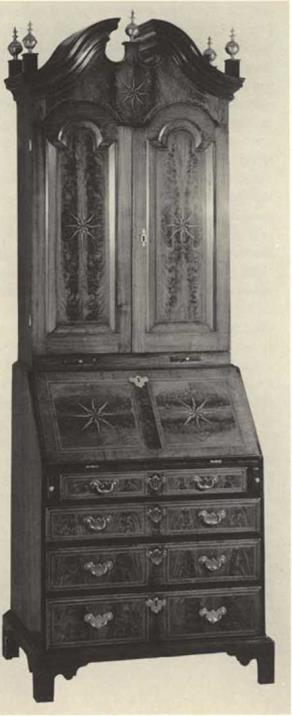 Ж Desk and Bookcase. Boston, c. 1720-1740. Walnut, white pine, anil maple; h, £8% in dies, w. 29*/!i inch», D. из1/! inches. (Museum of Fine Arts, Лояогі, M, and M. Kaiolik Collection, $9.170.] See also fig. 71. ГІ1І1 desk and iwhiw descended in the Avery, Grcenvugh, and Townsend families of Boston. It exhibits motifs Such as the inlaid ‘’compasses ’ which are found in abbreviated form Oil the юр of the contemporary Joseph Davis dressing table.
Ж Desk and Bookcase. Boston, c. 1720-1740. Walnut, white pine, anil maple; h, £8% in dies, w. 29*/!i inch», D. из1/! inches. (Museum of Fine Arts, Лояогі, M, and M. Kaiolik Collection, $9.170.] See also fig. 71. ГІ1І1 desk and iwhiw descended in the Avery, Grcenvugh, and Townsend families of Boston. It exhibits motifs Such as the inlaid ‘’compasses ’ which are found in abbreviated form Oil the юр of the contemporary Joseph Davis dressing table.
|
|
71. Interior oh Disk and Bookcase. Boston. (Museum of Fine Arts, Boston. M. and M. Koirobk Collection, 39-17*-) See also fig, 70, Surfr motifs as the shrill aboveihr bookcase Seetioii and thefulfil pilasters in the desk ііііґпаг art found in abbreviated form in the contemporary Coil desk ami bookcase.
|
|
72. C Ef еіт-on-Ch est, Liston дгса. c, I7jfr’i? j0. Mahogany and red cedar; h, S7 inches, w, +J‘/2 inch», d. 21% inches – (Lhnsburg and Levy, Inc.. New Yorit City,) The sweeping bonnet end the Jours in front ef drawers in the upper sttthtn mark this group of ehesls as miuual anil early.
|
|
1Ъ. Dist AMD Booxcase. England, с. 171°- H, 10+ inches, W – Аг inches, d ij inches. (City Art Gallery, Bristol, England.) This English desk with its attiring pediment mid mtsstJ indentation jtj the lower section may be related to such American hlocijronls as that illustrated in
fa 7*
|
|
74. CkssT-ON-CHEST. Attributed to Nathaniel Treadwell, Beverly, Massachusetts, c. 1780-1Soo. Mahogany and white pine; H. 92 inches, W. 4aУг inches, t>. 24 inches. [Vale University ArrGallery, Mabel Brady Garvan Collection.) See also fig. 75. This popular itSlgn was pfothlcfd thtoiighml the Hoilcm area.
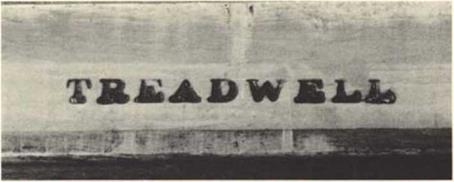 |
(figs, 72 and yfi). There arc three known examples of tins typc. as The use of doors in front of the upper set of drawers and the presence of a very baroque pediment imply an early date—probably the 1740s.
One might doubt the American origin of a chest with such a pediment. or the Boston provenance with cedar and oak substituted for die more habitual white pine secondary wood, but there is good evidence that this group of chests is indeed a Boston product. The construction is that of Boston, with the giant lower-frame dovetail and the run-chrough drawer dividers, And the design elements, including stiff bracket feet and central ornamental drop, are certainly Boston characteristics. Although two of the chests have lost their prc-iwen – rieth-emmry history, the one at John S. Walton. Inc,, New York, is said 10 have descended in the Green family of Boston*26
і;. They are owned by Yale, Ginsburg ліні Levy, Int., New York, and John S. Wilton, Inc., New York, They art made of mahogany or walnut with unusual secondary woods: the Ginsburg and Levy interior is red cedar, Yale’s is while oak and chestnut. Walton’s has rite usual while pine, but lacks the doors over the upper set of drawers, The Ginsburg and Levy chest has mirrored doors, a drop below the bottom front, and a molding between the lop and bur tom halves; the other two lark these additions. A similar example with inlaid stars, side columns, and a bonnet top is owned by the Henry Ford Museum.
26. "ft is thought by the family that this piece was made for Dr. John Sprague of Dedham, and it is known to have dese ended in the Swetr and Green families. Samuel Sweft. of Boston, married Elizabeth Sprague in 1 Boo," Letter to the aulhor from Hue! Kimball of John Walton, Inc.. March 2, iy? j.
Oiu~ might be led to suspect that the heavy baroque pediment with its nch curves is Continental in inspiration, perhaps Dutch. However, the closest parallel to this form is found in England, A desk at the Bristol City Art Gallery, said to be English, c. 1710, shows a rudimentary form of blocking in the bottom section and a rich undulating pediment above the doors (fig, 73). It is not unlike the three Boston “baroque” pediinented chests, although not an exact prototype.
In this unusual form may be seen a principle of Boston design which distinctly separates it from Newport work. The bottom section is blocked m a tripartite three-dimensional fayadc, while the top section is quite Hat and linear (except in the capping elements), and follows a design pattern independent of the bottom section. This division between halves does nor occur in Newport; there the design motifs echo and refer back to one another throughout the composition, In Boston there is a seemingly determined juxtaposition of linear with plastic elements, of top with bottom section.
There is another, later, distinctive group of chcst-on-chcsts in which the blocked lower chest supports a flat-fronted series of drawers above (figs. 74-77). These upper drawers arc fhinked by fluted pilasters and arc capped by three smaller drawers whose line echoes the curving pediment. Quite a few examples of this design survive; it seems to have been a popular solution to the problem of elegant storage. Although one might at first assume that this design type was characteristic ofa single craftsman, examples do not derive from a single shop Or even a single town. They represent the efforts of at least four cabinetmakers working north of Boston in such disparate areas as Charlestown, Marblehead, Salem, and Beverly. This fact is significant in view of the standard method of furniture attr[button which tends 10 see similarities or identities of design as an indication of the work of one workman. This is a more appropriate procedure in rural areas where individual idiosyncrasies in detail, proportion. and design are fostered by isolation. But in the urban environment such similarities arc no sure guide to a single source. A good businessman evidently kept his eye on his neighbor’s success-
ful wares and adopted diem when the public showed enthusiasm.27
One of the chcst-on-chcsts of this type is in a private collection and bears the label of benjamin Frothmgham whose shop was in Charlestown (fig. i).[42] [43] [44] [45] [46] [47] [48] [49] [50] Frothingham descended from a prosperous family of chaise – and coachmakers. The products of his cabinctshop arc well known today because quite a few pieces of furniture—tables, desks, high chests, bodi fiat and blocked—bear his label. The practice of labelling furniture was not common in Boston, A label was apparently both a guarantee of quality and an advertising device, especially for furniture shipped as venture cargo. As ins work is identifiable, Frothiiigham’s name is well known and anonymous products arc often attributed to his workshop.
As dose as the privately owned Froth ingh am chesi-on-chcst is to the similar example in the Gar van Collection (fig, 74), however, it is likely that the latter is the wrork of Nathaniel Treadwell of Beverly.29 It is stamped "TREADWELL’1 five times on the interior structural members (fig. 7s).30 The Treadwell name is considerably more obscure ш American cabinet making history than that of Frothmgham. Treadwell’s interpretation of the typical Boston-area chest-on-chest appears somewhat narrower in the top section than the other two examples illustrated here: he has widened the pilasters and emphasized the upsweeping line of the cornice. It is, however, a well-proportioned interpretation of this familiar design.
Another little-known maker of a chest in this style is Abraham
|
|
76. Снеїт-ом-Сігкїт. Attributed to Abralism Watson, Saltm, c, 1.770-1780. Mahogany and white pine; H. Я4 inch», W. 41 inches, D. Ij’/j niches. (Private collection: photo, Samuel Chamberlain.) This then descended in the family of Abraham Wetrou, One of two surviving pieces by this matter, the chest shows a classic formula with inventive detail.
Watson of Salem (fig. 7b).31 Although the chcst-on-chcst presently in a private collection in Salem is not signed by Watson, its history of descent in the Watson family and its fabrication for the cabinetmaker’s own use support this attribution.32 It deviates from the archetypal model of this form in small irregularities in the pediment area, but its overall design is the same.
One of the handsomest examples of this form is that in the Museum of Fine Arts, Boston (fig, 77). It is unsigned and may be the product of a cabinetmaker as yet unknown. However, its striking resemblance and nearly identical measurements in the upper chest to the doubly signed Ebertezer Martin and Nathan Bowen oxbow chest – on-chcst (fig, 9s) indicate that its source may well have been the Marblehead workshop of Bowen and Martin.33
The form of cbcst-on-chcst seen in the previous four examples is particularly Boston in flavor. It combines a blocked lower chest with 3. flat-fay aded upper chest of drawers yoked across the top by a beaded drawer outline and contained within pilasters. A stiffly carved fan and swan’s neck pediment complete the decoration of the upper case. Such a composition harmoniously unites diverse, almost antithetical dements. When the form firs: appeared is not known, but Watson is said to have made his chest for his new house in 1770. Frothingham worked until 1809. and Treadwell’s only known date is 1799, Thus the style spans the last quarter of the eighteenth century and probably intrudes into the nineteenth.34 This extreme conservatism—die clinging to a vital high-style aesthetic formula considerably beyond its
Jl. Watson WSIS Wodting between I7J7 and 1761 and possibly in 1750. See Dean A. Falei, Jr., Essex County Furniture Documented Httasuresfrom Ілеаі Collections t660-1S60 {Salem. Massachusetts, іуЛ$), fiR. 44; Веяло M. Попит, "Salem Tradesmen and Craftnneo Cirta 17*5: A Contemporary Document,” Essex Institute Historical Collections, evil (January, 1971), fij, 77,
Jt Samuel Chamberlain, Sufrui Interim; Two Centuries ef New Finland Taste and Decoration (New York, p. Sj; Fales, Біті’ County Furniture, fig. 44.
3j, Richard Ы. Randall, Jr., American Fsimiture in the Museum 0}Fine Arts, Biuttm (Вонов, ірОД, fig. 41.
І4, A block imm chestчзп-cbcst signed by Nathan ttihwen 0Г Marblehead and dated 1774 tics min this period a; well, bee Richard H. Randall. Jr., "An High Непі h Century Pannership," Tllf j-ігГ Quarterly, XXIII (Summer, 1960), IJJ-tSl.
ostensible period—is perhaps indicative of the gradual waning of Boston as a commercial giant and generative style center in favor of the newly wealthy towns of New York and Baltimore. However, the documentation of these four chests is most important as a testament of the multiplicity of producers and widespread popularity of a single form throughout the Boston area.35
Boston was a foremost mercantile city during the long era of blockfront popularity, so it is not surprising that some of the finest blockfront cascpicccs arc desks. These rich і у grained mahogany sculpturesque desks often stand on bold claw and ball feet, and imply by their grand scale of design the worldly competence and solidity of Boston’s successful citizenry. This class of blockfront, the Boston si ant-lid desk, was apparently made in large numbers and many survive, Most have been found in the vicinity of Boston, but it is evident that they were also shipped outside the nnmediate area. A walnut desk of this type on суma bracket feet was located in Maine before the close of the eighteenth century—as the inscriptions by members of die Wasgatt family of Mount Desert attest,36 But both the histones and the makers of most of the Boston desks exemplified by figures 80 and 81 are obscure.
One prom incur exception to the general anonymity of this form is a large, handsomely figured mahogany desk on hairy pawr feet in the Historic Deerfield Collection {figs, 78, 168, and 169). It is labelled by the celebrated Benjamin Frothingham (fig. 79}, Although the desk has been restored,37 it is essentially in its cightecnth-ccntury guise and may serve as an introduction ro the others of its type. All of these desks are very well made with neat, tight dovetails, boldly
lj. Another of the пищу «ітрій of this form ii to be found in the Bennington Museum, Bennington, Vermont,
їй, It bears the names “E. Wasgatt," "Sarah Hayes Wasgatt,’1 and "Mary Was- gatt,” They were the daughter! of Thomas Wasgatt of Maine; “£. Wasgatt," Eunice, married David Bradsireet 0Г Mount Desert in 1791, so this desk must predate that marriage, It is now in (he Clarvan CoUccrian at VaLe.
І7- The fall front and central interior fan-carved door are new, the bottom of the case has been replaced in part (the front four inches are new}. The brasses have been changed twice.
|
|
71. Chest-OM-Ciiest, Marblehead, Massachusetts, area, c. i"^0-i7^o. Mahogany and white pine; it tji’/j inches. w. 41 ‘/a inch a, d. 14*, inches. (Museum of Fine Am, Boston, Bequest of Mrs – Sarah W, Whitman. 04.1737.) 1’he visual discontinuity between the upper and kuttr set nans of this (best if typical of BoStOn-ate design.
|
|
78. Desk. Made by Benjamin firochmgham (paper label), Charlestown, c. 17551790, Mabogahy and w! li[c pil)i‘L її. 49 Уг inches, W. 45 “/7 inch**, 0. ljVa inches. (Historic; Deerfield, Inc., Deerfield, Massachusetts.) Sec also figs. 79. 1<*Я, and 169. Of П’ of the ttwtf successful of BoSton-arctl blocltjrortl designs, I Is і і exampie stands on fkgtmt hairy paw feet.
carved details, and precise stately proportions.39 tn terms of design and elegance, these and the desks and bookcases form the grandest group of Boston block fronts.
A desk in the Garvan Collection of this type (fig. So), traditionally
1*. This dole differs in cctutrattkm with д high chest signed by Frothingham in the Winterthur Museum. See, in particular, ihe dovctaOi and drawer tunners—[In – latter і is ihe Deerfield desk Hive vertical insets, a very unusual feature.
|
79, Detail or Papek Label on Desk; "flcrjn. Frothingham / Cabbi net Maker / IN / CHARLESTOWN, NE." [І Ііяагіс Dccrhcld, fnc.. Deerfield, Massachusetts.) See also Mgs, 7S, tfiS, and IG<). |
said to have descended in the Winthrop family of Boston, is very milch like the Deerfield desk, It differs principally in the arrangement of the interior. The Garvin desk exhibits the classic formula for Boston blockfront interiors: the bottom tier is flat, plain-fronted, and on an advanced plane. The central fan-carved door is flanked by nil – fluted colonnettes, paired pigeonholes above notched single drawers, and finally by fan-capped pairs of shallowly blocked drawers,39 This formula changed, however, as the century’ progressed. By the 1760s Newport was making extremely fine furniture and one finds, curiously enough, in such an example as the Boston desk illustrated in
jp. En ihe Museum of Fine Am, Boston, is a desk almost identical in fbtra and флата» n.
figure Si an echo of the standard Newport formula for desk interiors (fig. 82.). Still evincing the Boston preference for the advanced lower tier and the stiffly carved fans, the example illustrated in figure Si adopts the Newport concave arched draw ers above the pigeonholes. That the influence is that of Newport on Boston is more definitely established by a handsome but hybrid Massachusetts desk and bookcase at the Museum of Fine Arts, Boston (fig, Kj), Its interior is wholly after the pattern of Newport except in the retention of the colonnettes on the document drawers. The adoption of the Newport style, however, is strictly confined to this interior section— the gen-
|
80. Desk. Boston arts, c. 1750-1770. Mahogany and whitr pine; к 44 Vi inches. цг. 46 Vi inches, t>. 13 Vi inrhes. (Yale University Art Gallery, Mabel Brady Garvan Coliretion,) This fiw-tfmft/ desk interior uras mu(h favored in ffoddfl. |
cral construction of this desk and bookcase.1 and its decorative details arc distinctly Boston.
The autonomy oi regional styles was based upon isolation of one style center from another, and other more complex factors. The preferences of patrons, the apprentice System, and the independent specialist suppliers were major factors in the codification of a style, and may have done much to produce die local unity of a ‘‘school." But intercity trade and communication in eighteenth-century New England was lively atid the craftsmen in Newport and Boston were certainly aware of each other’s products.
|
81. Desk. Boston area, c. 1760-1780. Mahogany and white pine: h. 44% inches, w„ 4t inches, D. 211/, inches. (Museum of Fine Arts, Boston, M. and M. Karolik Collection, 39.87.) The influence of Newport is evident in the cusped pencil drawers. |
|
82. Is ті. и юн of D? hK. Made by John Tovnucnd, Newport, !7tSj. Mahogany, cedar, and in lip wood; fi. 4; iiich«, W. 4 a inches, n. 1} indie*. [Israel Sark, Inc., New York Ciry.) For an overall view of the desk, see Апііірю, Cl (January, 15)72), inside cover. Tht archetypal Лгггvpori dirsk initrier in a dgittd and dawd example. |
Tire movement of craftsmen from Boston to Newport may be documented from early in the centuryd° But perhaps more important for the migration of furniture styles were the dose commercial ties between merchants ш both cities.41 Stephen Green leaf, a wealthy merchant о I Boston, supplied his friends in Newport With furnishings and paintings commissioned in Boston. In a letter of May 26, 1749, to Abraham Redwood, in Newport, Green leaf records: “i receiv’d yours pjerj Friend Proud and have ordered the Chain and two roundabouts to be made which will be strong and neet and not high pris’d—have searched ye town for a | Looking] Glass and can have some of ye Size you want @ £.75. but there is some Guild mg about them which you wont like; I design to get one made for you that will be plain & hope will please—# shall have it ready in a fortnight, and possibly ye chain may be done to go with
40, William Claggrtt, tincktПікет, thdvl’J faun Bmion m Newport in 1716. Janies Franklin, 11 ic brother of liciijiinin Franklin, moved bit printing business 10 Newport III 1717- Samuel Ciscy, a silversmith ofRbode Island, served bis appfftllLvc – sliip m Boaton and sci up shop outside Newport about 1730, to mention a ftw cat an] pics,
4t. Godfrey Mjlbt’iie jnd the ilcbinii family miintiincd larpe commercial nub – lishmrnts in (null cities.
|
|
83. H>F, SK and Вооіїслііе. TSosron іґеа, с 1770-1 коо, Mahogany, th«miir, white pine. j]iJ tulip wood; И. yj% inches, W. 42% inches, d, і; inches, (Museum oFFine Arts, Boston. M, and M. Karol 1 к Collection, 156,] According tofamily rruditiart, this desk and bookcase descended uj tkt Cooke family of Rhode Island. The injluenee ofeu>pon is pronounced in the desk inlaior, but the exterior appearance, міг constntclion, and interior colonnettes arc typical of Boston.
it."*3 Such Massachusetts-made – furnishings sent to Rhode blind might well have included biockfront cascpicccs which were seen, imitated, and adapted by local craftsmen.
The adoption of the blockfrom facade by Newport craftsmen around the middle of the century is more easily understood than the apparent countercurrent of influence which occurs a decade or two later. The use of Newport-type desk interiors in Boston has been discussed above. By far the most significant influence on Boston-arca block fronts by Newport is seen in the products of Salem. In that area. Newport construction techniques as well as design principles fuse with the native product to produce a wholly distinctive style. The use of a blocked desk lid, of squared (rather chan slightly rounded) comers on the blocking of the top drawer and the use of the flat mahogany strip instead of the giant Boston dovetail at the bottom of the case are Newport elements found ш Salem blockfronts of the 1770 to 1790 period.
The source of the Newport influence in Salem work is not clear, but it may be a result of the close connections maintained among Quakers in cightccnth-century New England. Ezra Stiles, a curious and faithful observer of civil and religious matters, records: "Quakers In New England arc resolved into 3 Quarterly Meetings of Business & One Yearly Meeting of Business. The three Quarterly Meetings are Salem, Sandwich, and Newport, , , . Delegates or mes – sangers from the two Quarterly Meetings of Solein and Sandwich assemble at the Yearly Meeting of Business in Newport. . . . The whole state of the Quaker Interest in New England is from year to year transmitted by the yearly meeting from Newport to the General Meeting in London. MJ3 The Townsend family—well-known
4a. Abraham Redwood, Lettcrbook, ffi, 7 (Newport Historical Society). Set also William Ellery, Daybook, t7}7. folio 7i (Newport Historical Society): "Father Літу [kin to Townsend cabinetmakers) in 1 barrel! of Loaf sugar bought for you in В cm on by Creel ileaf 10 a Try ion painting; Sr carting 130^:6."
43. Ezra Stiles, Miscellany, 1758-17(1», p. jjy, undated cutty ptobabty lydl (Всі – песке Library, Yale University). Several accounts, such as those found in the Jonathan (?) Marsh Account Book (Newport Historical Society)—where notations for І7І4, i7Sd, and 17*4 suggest that the scope of the Newport meeting was enlarged 10 indude delegates from the Jerseys, 1’hiladelphb, and England—attest to the accuracy of Stile’s report.
makers of the Newport blockfronts—were staunch Quakers as wrcrc other lesser-known Newport craftsmen. Perhaps the Yearly Meetings facilitated friendships and exchanges which introduced Newport design and construction techniques into Salem work.
Whatever their source, the Salem Ыос к front desks are distinctive.
|
|
SM. Oesk. Made by Henry Rest, Salem. e, 1762-1800. Mahogany and white pine; и. +4 indies, w. 41’/; inches, d. :: inches. (Ginsburg and levy, Inc-, New York City.) See also fig. 85. Feature! of (ill’s dedt^siputte-cornercd blotltittg, realistic ornamental scallop shell, blocked desk lid, ontі Newport-typt соя ашЛ/іШіоп—ore distinctive of Salem.
|
85, ОвтАЇЇ, or Carvtd Inscription os Ucjttom or Desk: "H x Rum." (Ginsburg and Levy, Inc., New York City.) See also fig. Hj. |
The only signed example was made by Henry Rust, a little-known cabinetmaker who worked in Salem, c. 1762 to 1800 (figs. 84 and 85),^ The Rust desk stands on dwarf cabriole legs with claw and baii feet and undulating brackets of a type well knowrn in the Hasten area. Tile use о fa central drop is also a Boston-area characteristic, but here ornamented with an unusually three-dimensional, realistic scallop shell. This three-dimensional shell is a recurring motif in the desks of this group. The blocked desk lid is also peculiar to this group—echoing the use of the blocked lids in Newport work and here producing the same effect—a unified facade, the parts of which refer to and echo one another. E Eowever, in the examples of this type which include a bookcase the Boston custom of a clear delineation between the decorative pattern of the top and bottom halves prevails.
A related monumental desk and bookcase was purchased by Joseph Waters of Salem about 178a and descended in the Waters family, it is an archetypal example of this Salem form (fig. 86), 45 incorporating
+4. The signature on this piece is a gouged "Ed к Rust" (m the bottom of the ease— an ULUSSU. il but not ins plausible шгапї of identifies! tion (fig – Ss).
4S – In the registrar’s tit« it the Winterthur Museum there is a photograph of thii desk (e, IS"?!)) with the captions: "threat Grandfather Joseph Waters’s Desk: sold by Sarah W." and "From Cousin FLtz. Vlusro nf Great Grand father Waters’s Desk and bookcase, Muity Mott leaning against ir. Waters’ Mouse. Washington StjUatr [Sj – Jein|." Sec Joseph Downs, 4Я! гпш ПтггГкгг, Queen Лппе and Ctiipptndnle Prtiods iit the Hmry Prjncii du Peru ll’mlfrthur Mufeum (New York, Itjjj), nu. ±15.
Йб. Desk and Bookcase. Sitcm, c. 1770-17530. Mahogany, white pint, jnd white cuk; H. нлз inches, W. 41 inches, D. 23 inch». (The Henry Francis dii Port Winterthur Museum, ) SgugAt by Joseph tV’ain-f (l7s6-ltjj) of Salem, this Jtsk and ІлЛішіє Jeicendeii г >i frri family.
|
|
87. Desk AND BOOXCASE. Salem area, t, 1770-іЯ«іг Mahogany itid white pine; H, тої inches, w. 4i inches, n. ij inches. (The Metropolitan Museum of Art, Gift of Mrs. Runet] Sage, 1909.) The figures on this ileslt and boohease were eatvtd by the Sttillin family.
the blocked desk hd, three-dimensional scallop shell, and Newport case construction seen in the Rust desk, A similar desk and bookcase with Skillin-family carved allegorical figures on the pediment is in the Metropolitan Museum of Art (fig. 87), Another example of this type is in the Garvati Collection at Yale (fig. 88),4й and a fourth is owned by Ginsburg and Levy, Jnc„ New York (fig, 89}, With slight differences these desks all conform to the same general design and construction principles, and were probably all made in the Salem area. Their significance lies not only 111 their handsomely rational design hut also in their testament to the communication and exchange of ideas between Newport and Boston-area cabinetmakers.
The movement of design ideas between communities was not confined to the stylish urban centers and the prosperous North Shore communities, Joseph Hosmer of Concord (1736-1821), although trained by an immigrant Frenchman (Robert Rosier), appropriated the boston sy ties.1,7 fie was. according to con temporary accounts, “a farmer and a cabinetmaker, ‘ a yoking of vocations not unusual in rural communities.48 When called upon to make a distinguished piece of furniture for the new house (built in 1769 and now known as "the Old Manse") of Concord’s eminent clergyman William Emerson, Hosmer employed fashionable blocking to Update and refine an old form—the high chest (fig. 90), Шос к front high chests are rare—perhaps because of the fundamental visual disharmony of “animal" legs supporting an architectonic shape. It is significant that the biockfront motif was so well known and widely understood as an index of status that it И borrowed and misapplied even when it contradicts the integrity of die basic form.
Jn another sense, the importance of this biockfront is considerable
+6, It bean the inscription "William H, Alim,** probably 1 nineteenth-century owner of the desk.
47. According to ThrCmtmma! of iht Scan! Circle in Confard {Cambridge, iMi), p. 1 і 4, Joseph 1 Ioniser’s lather, James, "purchased. . . [hr farm belonging to Joseph
SheVilly, a Fjchrhlisals, whu married his cousin Sarah I insurer___ Robert Rosier, a
Frenchman, married Mary Chevally, and lived near the bridge. , . . He w« a very excellent cabinetmaker, and Maj – г Hornier learned his trade from him."
4З. Cited {nu source given) in a letter to the author from Amelia F. Emerson, March, 1973,
because it is the only instance m which the maker (and the maker’s teacher), the date of manufacture, the patron, and die house for which a block front was made are all known. Although there arc no inscriptions on the highboy itself, the static nature of Concord reinforces the probable accuracy of this tradition of fabrication, ownership, an J residence.”" The imposing height of the high chest and the use of high-style decorative motifs imply a social statement consistent with the status of an important clergyman. The blocked facade is a nod toward the refinement and elegance of contemporary urban establishments of distinction,
Perhaps the masterpiece of the Boston biockfront tradition is the handsomely proportioned and exquisitely detailed desk and bookcase illustrated in figure 91. The patron who commissioned this work was Colonel Josiah Quincy (1710-1784), an extremely wealthy gentleman, He had retired from commerce in 1748 when a single venture of his ship Bethcll, a privateer, netted him one hundred sixty-one chests of Spanish silver and two chests of gold.5’1 The desk is inscribed: "This desk was / purchased by, josiali Quincy / Braintree 1778," In 1770 Colonel Quincy had rebuilt his house in the latest taste. "At that time," records Eliza Susan Quincy in the mid-nineteenth century, speaking of the 1770s, "it was considered as a spacious and elegant mansion. The house still stands in Quincy, overlooking the harbor. The purchase of ibis desk may have been necessitated by the loss of furniture in the fire of 1769 which destroyed the original house. However, it is probable that it was inspired by a wish to acquire elegant furnishings worthy of the fashionable new intenor, as several considerably older pieces of furniture evidently survived the fire.[51] [52] [53] [54]
|
|
ftS. Desk and boo kc ask. Salem area, c, 1770-13™. Mahogany and white pine; H. 100 inches, w. 45 l/t inches, d. 44% inches. (Yale University Arr Gallery, Mabel Hrady Oarvan Collctrion.)
According to the inventory taken at Colonel Quincy’s death in 1784, a desk and bookcase, valued at a considerable /7:4:0 (the only desk and bookcase in the house), was located in the cast lower room, This room was evidently the best parlor for there are found also “1 Marble Slab Mohogany Frame Jpier table) 5ft [shillings]” and such accoutrements of the elegant life as a “Glass Pyramid," a hamper of Quccnswarc, and “li Fruit Knives &’ 12 Forks Silver handled." Such a place was suitable to the proper rococo dignity of the Quincy block front. But unfortunately it was made toward the end of the Chippendale style period, and the thin right rectilinear Federal style soon eclipsed its artistic virtues and status value. According to Eliza Susan Quincy, a “carved desk and bookcase"—almost certainly this one—was “bought by a farmer in the neighborhood [but) was bought back in 1Я40 and is now in the possession of the fin 1 lily."53
The maker of this blockfrom is unfortunately unknown. Its details of construction and design are unusual in some respects (for instance, the thinness of the drawer sides), but consistent with Uos – ton-area practice. The secondary wqchJ is red cedar in the larger drawers, and mahogany in the desk interior. Perhaps the most striking aspect of this monumental desk is its carved details.54 Elegantly conceived and executed, they tie the composition together and emphasize its plastic architectural quality.
Colonel Quincy was a man of richly refined taste and a patron of the arts. His portrait by John Singleton Copley, painted in 1769, portrays a man of elegant solidarity, his dress highlighted by light rococo details (fig. 92). In similar fashion the solid, formal Queen Anne structure of the desk and bookcase is punctuated by airy, even whimsical touches in the carving. The American interpretation of the rococo mode in all the arts followed this partem of fashionable, delicately rococo touches on an unmistakably solid structure. In this
53. "Lilt of Pictures jnd Furniture etc. in the House built i77o in 18751, by Eliza Sunn Quincy," pp. yi-33 (current location Ullbiow [phntnsut fnpy, Winterthur Libraries, Joseph Downs Manuscript C < dleeticin ]).
54- Simibl Curving is found cm the fat nnd drop of several other Bostoti-Лса blocked Case pieces, inidstding u smull chest owned by Cinsburj* und Levy, hlf,, uld the desk uild bookcase illustrated in figure Sj.
|
|
вї. Dili and Book сл si. Salem area, c. 1770-1Й00. Mahogany and white pint, h, 100 іги’іісі. w, 4J inches, p, 2j inches. (Ginsbnrg and Levy, Inc., New York City,) CiMiffliW with orhtr ekmrFrfr/LmriW to (hisgroup of dak* [stt Jig. &)) art fin rrminixent of tht tlasitt Newport rypt.
|
|
90. High Chest. Attributed to Joseph FFosmcr, Concord, Massachusetts, c. 1709. Cherry, ттріе, and while pine; H, ЯЯ inches, w, 40l/z inches, n. 21 inches – (The I lenry Fruieis du Pom Wimerchur Museum.) An unusual and invctiiii’t* design, this rural adaptation of high-stylt blinking contributed to iht wet Id! у shout of the Reverend IViF^ium Еіггсггел in his Cone or d home
ntui’ known as "The OldMouse"
sense the Quincy desk and bookcase is as much a monument of its country and period as the great Philadelphia high chests. It is an artistic fabrication composed of diverse dements which arc transformed and integrated into a successful whole. It represents the summit of Boston block front design and equals the celebrated block – fronts of Newport,
This survey of blockfronts attests to the vitality, diversity, and longevity of this form in the Boston area. From the 173 S Job Coit desk and bookcase through the developments ofjoseph Davis, Abraham Watson, Nathaniel Treadwell, Benjamin Frothingham, Henry Rust, and Joseph Hosmer to the 177 Я Quine у desk and bookcase, the fertility’ of design imagination seldom fails. The style of ПО single man, the bloekfront was made by the polished urban professional and the rural cabincimakcr-farmer. Contemporary patrons from the Wasgait sisters of Mount Desert. Mains’, to the elegant Colonel Quincy of Braintree enjoyed its aesthetic and social attributes. Few’ other purely decorative design motifs knew such uniformity of principle yet such diversity of application.
Because the blockfronts of Boston antedate those of other regions, it might be assumed that it is from this center that the idea of block – front case furniture spread to Newport, Connecticut, New – York. Delaware, and Virginia. Nowhere except in Newport, however, did the enthusiasm for die form equal diat of Boston. Curiously, these handsome, solid, baroque forms appealed to the New England temperament where, it has been thought, pragmatism, “plainness," and prim modesty prevailed.
The mistaken attribution of Boston blockfronts as Newport products will perhaps cease, yet the curious mystery of the source of the blockfronts continues. Nothing precisely like the style* of blocking as it is known in this country has been found abroad. Undulating facades are often found on French furniture of the late seventeenth and eighteenth centuries, but the focal point is generally all advanced pavilion rather than a recessed niche. German and Spanish eighteenth – century cabinetwork exhibits a wide variety of vertically undulating facades, but these examples are usually undated and are not direct
|
|
prototypes. England produced some flatly blocked casepicces which exhibit і restraint and understatement of baroque movement similar to American blocking practice. The English desk and bookcase illustrated in figure 73 is not an isolated phenomenon, A small desk with a recessed central panel is similar, and a group of seven or eight British desks and bookcases is known which is related to one (in the Victoria and Albert Museum, London) said to have been bought by Dean Swift in 1710 (fig, 93). The recessed pedestal blocks of this last desk are reminiscent of American work. Unfortunately, even less is known about these European and English examples than about our own products. It is not likely that the mystery will be dispelled here before substantial research has been done abroad.
Boston, however, was distinctly the generative center for die creation and practice of the block front formula in this country. The groups of examples discussed in this study do not begin to exhaust the list of types and variations of blockfronts produced in the Boston area. By anchoring the discussion in the particular—and where possible the labelled, documented example^I have attempted to suggest (perhaps at the expense of the unique example or completely anonymous group) the general range of production and quality. Underlying the rich variety, however, are certain common design principles, construction techniques, and cultural preferences. The Boston cabinetmakers of the eighteenth century constituted a rich, inventive "school," and to them should go the credit for formulating and popularizing that significant American experiment in furniture design—die block front.
91. Desk ane> Booxcasb, Hosttni arc*, 177a. Mahogany, red cedar, and white pine; n, 9ft!„ inches, w. 43 inches, D. zj inches. (The Henry Francis du Pont Winterthur Museum.) Perhaps the most ambitions and finest of Bosfffl ЫоЛфаШ, (Ais desk was twught by Jonah Quincy (17 oj Braintree, Massachusetts, і pi j tjMJ, h rAf inscription on the desk indicates.
|
|
92. JOStіH Quinсї. PaintedЬуJolm Singleton Copley, 13 osfon, 1769, OiI on cjnva; si. 33% inches, w. 28 indies (colliding (hunt), (Dictrkfa Hrothen Апісгінпа Corporation.) A mo» of tune, Quitny is pichmJ here seat rJ solidly in а Chippendale tWr. The light rumro twlri in the Ida lire reminiscent of the airy caving ornamenting ike solid grate of the booheose.
|
|
93. DeSH AND JtOOKCA 5 E. EiI^LidJ Of ІҐІ’ЬшіІ. C. 1700-1720. II. #7 ІМСІІЇ1, w. 49 l ‘i inches, D. nJ.-i inches. (Victoria and Albert Museum, London.) Orre of a group of similar desks, this enc, said to hove fven owned by Jonathan Swift (l#7-l74j), displays lire use of retessed blocking on the pedestals.
|
|
|
|
|
|
|
|
|
|
|
|
|
|
|
|
|

![]()
![]()
-w GILBERT T. VINCENT ^

